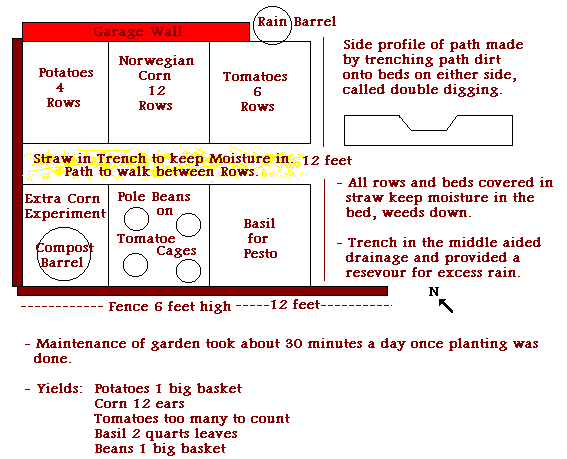
| |
 |
![]()
Gardening is one of those things that can really only be learned by doing. While there are many books and resources available to help, growing your own garden gives you the opportunity to see first hand the different problems that can be had in growing a certain type of crop. Growing a garden is also a way of putting yourself back into the cycle of the earth - being a part of things again. The garden in the picture is what I call an experimental garden. I do not expect to grow all my food out of it, but it allows me to grow a variety of different plants and allows me to get experience for the time when I might have to grow a really big garden.

The size and layout make it possible to maintain the garden completely, once the initial preparation for planting has been done, with about 20 minutes a day. A trench dug down the middle of the plot separates the two beds. The trench is 2 spades wide and the soil is turned up to form the bed. What this does for you is allow you to start planting very early, since the beds can drain into the trench, and the beds get warmer faster in the sun. This spring I dug the bed and the soil was so wet I was not sure I would be planting for several days, but because of the added air circulation, and exposure to the sun, the soil was dry enough in the beds to plant within two days. If I had kept it as a flat single bed, then I would have had to wait till the season was well started before I could plant.
The trench can also save your garden from being flooded out. I have a rain barrel to collect water, but I like to fill it up at the beginning of the season so that when I water I don't have to get the hose since the barrel is usually not always full. I got the hose and began filling up the barrel, then I got distracted and forgot I was filling it and 2 hours later remembered and ran back to the garden. The trenches were full of water, but the beds were dry. The tops of the beds were about 4 inches above the waterline. My crop would have washed away if the trenches were not there. The trench water ended up sinking into the beds and was not completely lost.
I also used straw to fill the trench so I could walk on it, as well as over the beds once the plants were up, to protect the soil from evaporation, and slow down weed growth. You can buy special cloth to the same thing, but in the fall, I just turn over the soil with the straw intact and it mulches up quite nicely. I have been planting different types of vegetables to get an idea of how they grow and what I can expect from bugs and how much care the different plants need. There has been talk about low light conditions Post PS and after checking around there are some plants that are growable in lower light conditions. These types of plants are the ones that grew and grow up in northern china and some of them are:
Leeks
Onions
Cabbage
There are more, but I do not know them. Of course there are mushrooms and they need no light at all but that is a different kind of gardening. I think it is really important to get as much active experience in gardening as you can regardless of how the PS might change the biosphere. The experience can help in assessing the PS conditions and give you a better chance of getting a successful harvest off then if you had to start from scratch post PS. But then again, any experience is better then scratching around after PS.
Offered by Gus.